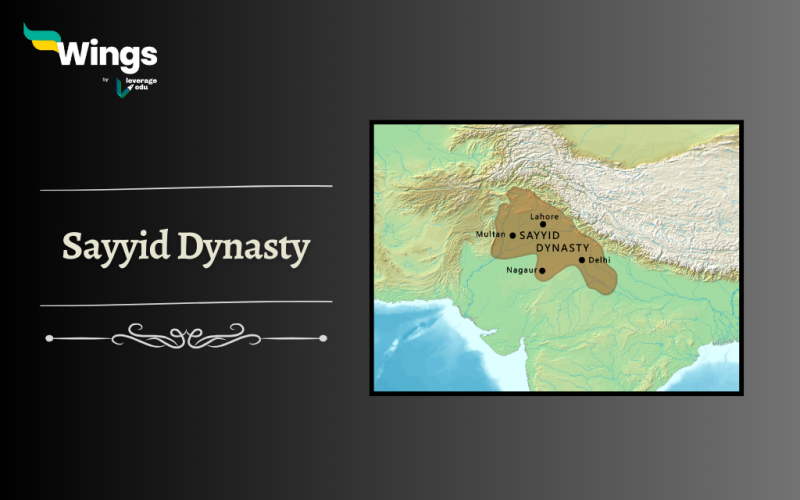The rule of the Sayyid dynasty is a significant chapter in the history of medieval India. The Sayyid Dynasty was founded by Khizar Khan, Multan’s former governor, in 1414. This dynasty superseded the rule of the Tughlaq Dynasty and reigned its rule from 1414 to 1451. During its rule of 37 years, the dynasty witnessed the rule of different rulers and was later replaced by the Lodi dynasty. In this blog, we will explore the origin of this dynasty, its majestic rulers, economic traditions, and architectural achievements.
Table of Contents
Origin of Sayyid Dynasty
The rulers of the Sayyid Dynasty were of the opinion that they belonged to the lineage of Prophet Muhammad, the founder of Islam. Accordingly, they asserted the supreme power and control over the throne. Khizr Khan was a supporter of Timur, a Turkish conqueror, and was appointed the Governor of Multan and Lahore. He continued to serve Timur and his son for several years. On 28th May 1414, Khizr Khan seized Delhi, thus establishing the mighty Sayyid dynasty.
Also Read: Lodi Dynasty- Exploring India’s Medieval History
Rulers of the Dynasty
Here are some of the most prominent Sayyid dynasty rulers.
Khizr Khan
Khizr Khan was the founder of the Sayyid dynasty and ruled from 1414 to 1421. However, during his reign, he did not claim to be the ultimate ruler. Instead, he reigned in the name of Timur. Similarly, the coins being used during this time bore the names of previous Tughlaq monarchs. Despite all this, Khizr Khan was successful in many ways, including keeping the dynasty safe from external conflicts. Accordingly, he was adorned with the title of Taj ul Mulk.
Mubarak Shah
Upon Khizr Khan’s demise, his son Muhammad Shah took the throne of the Delhi Sultanate. He ruled from 1421 to 1434 and tackled numerous uprisings against the dynasty. Moreover, Mubarak Shah built the famous city of Mubarakabad on the banks of the Yamuna River. Unlike Khizr Khan, Mubarak SHah used the royal title of Shah. He was also the first Sultan ruler to appoint Hindu nobles in his court of Delhi.
Also Read – Alauddin Khilji: Dynasty, Life, Reign, Military Conquests
Muhammad Shah
Mubarak Shah’s reign came to an end with his assassination and the throne went into the hands of Muhammad Shah, Mubarak Shah’s nephew. His rule started in 1434 and lasted till 1445. The reign of Muhammad Shah is often associated with civil unrest and a series of rebellions. Accordingly, he is considered a weak ruler of the Sayyid dynasty.
Alaudin Alam Shah
Alaudin Alam Shah was the last ruler of the Sayyid dynasty. Owing to his fondness for a luxurious lifestyle full of pleasures and privileges, he became an incompetent ruler. Moreover, he was dethroned by Bahlul Lodi in 1457 AD which ultimately marked the beginning of the Lodi dynasty rule.
Also Read: Kushan Dynasty: Rise, Kings and Decline
Architectural Achievements of the Sayyid Dynasty
The Sayyid dynasty was truly an era of civil unrest and turmoils. Owing to the lack of resources, the rulers of this dynasty could not contribute much to the overall architectural developments. Nonetheless, there were a few significant construction projects.
- The city of Mubarakabad- It was constructed by Mubarak Shah in 1433 AD on the banks of the Yamuna River.
- The city of Khizrabad- This city was founded by Khizrabad in 1414 AD on the bans of the river Yamuna.
- Tomb Of Sultan Mubarak Shah– This tomb stands as the beautiful architectural epitome of beauty. Although some parts of the tomb such as the gates no longer remain, its octagonal courtyard and three entrances still pique the interest. Moreover, it was constructed during Mubarak Shah’s lifetime. Located in Delhi, the tomb of Mubarak Shah is now renowned as Kotla Mubarakpur.
- Tomb Of Muhammad Shah- The Tomb of Muhammad Shah is located in Delhi’s famous Lodhi Gardens. It has the traditional design of royal tombs such as an octagonal chamber with an exterior arcade.
Also Read: Chola Dynasty: The Golden Age of South India
Economy Under Sayyid Dynasty
Trade and the economy under the Sayyid dynasty were not thriving for numerous reasons. It was less prosperous than previous Sultanates. However, this weakened economy was caused due to factors like the construction of major sites, Mongol invasions, regional instability, and mismanagement of resources.
- Taxation: Since agriculture remained the backbone of the economy, excessive taxation was imposed on poor farmers and peasants. This not only increased their financial burden but also increased hardships for common people. Moreover, Sayyids introduced corn taxes that were eventually eliminated by the Lodhi dynasty.
- Coinage: The coins during the Sayyid dynasty bore the name of Tughlaq Khan. Although Mubarak Shah, during his early years did not issue new coins in his own name, he later minted uncanny gold and silver coins.
- Construction: Despite the above-mentioned economic hardships, the Sayyid rulers were engaged in numerous construction projects. It includes the construction of popular roads and a few architectural structures.
Also Read: Satavahana Dynasty: History, Rulers and Decline
Religion Under Sayyid Dynasty
The previously ruling dynasties were of strong religious opinions and had been mainly Muslims. However, the Sayyid dynasty was more tolerant and thus, allowed a multitude of different religions to coexist. Although they were strongly committed to their Islamic faith, they still followed numerous religious practices and traditions established during the earlier Delhi Sultanate period. This period also witnessed a major rise in the Sufi and Bhakti movements.
Also Read: The Integration of Princely States After Independence
The Decline of the Sayyid Dynasty
The Sayyid Dynasty which ruled over the Delhi Sultanate for many consecutive years witnessed a gradual decline that marked the end of its era. This gradual decline can be attributed to different factors. Among others, one significant factor was the constant threat posed by Timurid invasions and the campaigns of the Bahmani Sultanate and other emerging powers.
- The Sayyid Dynasty during the reign of Mubarak Shah and Muhammad Shah was weakening with the increasing revolts within the dynasty. Upon ascending the throne, Mubarak Shah broke all ties with other kingdoms. This caused a series of revolts in provinces like Doab, Etawah, and Jaunpur.
- These external pressures weakened the central authority of the Sayyid rulers. Additionally, internal strife and the absence of strong leadership within the dynasty further exacerbated their problems.
- Economic instability and fiscal mismanagement also took their toll, leading to financial difficulties and a declining economy. Ultimately, the Sayyid Dynasty’s inability to effectively address these challenges led to its downfall, paving the way for the Lodi Dynasty to take control of the Delhi Sultanate, marking a significant shift in the region’s political landscape.
White the Sayyid dynasty and its majestic rulers like Khizr Khan managed to defend the Sultanate against all odds, but there were other challenges waiting to collapse the kingdom. Their successors such as Muhammad Shah and Alal Shah were unable to safeguard the throne. Consequently, the Sayyid dynasty’s 37 years of rule concluded with the succession of the Lodhi dynasty.
Results
#1. Who was the founder of the Sayyid dynasty?
#2. Who built the city of Mubarakabad?
#3. Who was the last ruler of the Sayyid dynasty?
Relevant Blogs
That’s all about the Sayyid Dynasty! If you want to know more about topics like this, then visit our general knowledge page! Alternatively, you can also read our blog on general knowledge for competitive exams!
 One app for all your study abroad needs
One app for all your study abroad needs
















